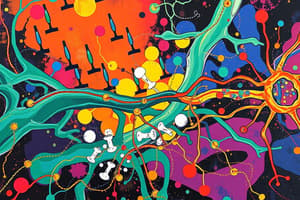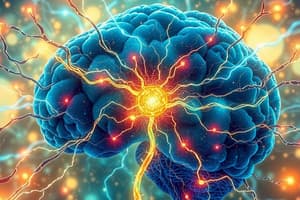Podcast
Questions and Answers
Which part of the brain does the basilar artery NOT supply?
Which part of the brain does the basilar artery NOT supply?
- Cerebral cortex
- Spinal cord (correct)
- Cerebellum
- Brainstem
What is the primary function of the terminal branches of the basilar artery?
What is the primary function of the terminal branches of the basilar artery?
- Control heart rate and breathing
- Supply blood to the spinal cord
- Supply blood to the cerebral cortex (correct)
- Regulate body temperature
Which of the following areas of the brain does the lateral cortical branch of the basilar artery supply?
Which of the following areas of the brain does the lateral cortical branch of the basilar artery supply?
- Medial surface of the cerebral cortex
- Lateral surface of the cerebral cortex (correct)
- Tentorial surface
- All of the above
Which statement accurately describes the relationship between the basilar artery and the cerebral cortex?
Which statement accurately describes the relationship between the basilar artery and the cerebral cortex?
What is the primary difference between the medial, lateral, and tentorial branches of the basilar artery?
What is the primary difference between the medial, lateral, and tentorial branches of the basilar artery?
Which of the following structures is supplied by the part of the temporal lobe near the inferior border?
Which of the following structures is supplied by the part of the temporal lobe near the inferior border?
What part of the temporal lobe is located near the inferior border?
What part of the temporal lobe is located near the inferior border?
Which of the following structures is NOT directly mentioned in the content as being supplied by a part of the temporal lobe?
Which of the following structures is NOT directly mentioned in the content as being supplied by a part of the temporal lobe?
What is the location of the medial half of the temporal lobe?
What is the location of the medial half of the temporal lobe?
Based on the content, which of the following is a likely conclusion about the temporal lobe?
Based on the content, which of the following is a likely conclusion about the temporal lobe?
What is the primary function of the association sensory area, located in the superior parietal lobe?
What is the primary function of the association sensory area, located in the superior parietal lobe?
Which of the following is NOT a supraspinal facilitatory area for the stretch reflex?
Which of the following is NOT a supraspinal facilitatory area for the stretch reflex?
Which of the following is a condition that primarily affects the blood?
Which of the following is a condition that primarily affects the blood?
Which of these arteries are responsible for supplying blood to the association sensory area?
Which of these arteries are responsible for supplying blood to the association sensory area?
What is the primary function of the dynamic component of a muscle spindle?
What is the primary function of the dynamic component of a muscle spindle?
What is the term used to describe the inability to recognize objects by touch due to a lesion in the association sensory area?
What is the term used to describe the inability to recognize objects by touch due to a lesion in the association sensory area?
Which of the following is NOT a function of the Association Sensory Area?
Which of the following is NOT a function of the Association Sensory Area?
What is the name of the fluid that flows from the lateral ventricles of the brain?
What is the name of the fluid that flows from the lateral ventricles of the brain?
Which of the following is a supraspinal inhibitory area for the stretch reflex?
Which of the following is a supraspinal inhibitory area for the stretch reflex?
What is an example of a condition that affects the ears?
What is an example of a condition that affects the ears?
Which of the following is a feature of the axoplasm?
Which of the following is a feature of the axoplasm?
A patient presents with difficulty in speaking, but can understand what is being said. The injury is most likely located in:
A patient presents with difficulty in speaking, but can understand what is being said. The injury is most likely located in:
What is the mechanism of action of Tolcapone?
What is the mechanism of action of Tolcapone?
Which of the following is responsible for the myelination of axons in the peripheral nervous system (PNS)?
Which of the following is responsible for the myelination of axons in the peripheral nervous system (PNS)?
Which of the following is a common annual follow-up investigation for type 2 diabetes?
Which of the following is a common annual follow-up investigation for type 2 diabetes?
Which artery supplies the splenium of the corpus callosum?
Which artery supplies the splenium of the corpus callosum?
What is the main function of the hypothalamus?
What is the main function of the hypothalamus?
Which part of the brain is primarily responsible for the formation of cerebrospinal fluid?
Which part of the brain is primarily responsible for the formation of cerebrospinal fluid?
What is the primary cause of hydrocephalus?
What is the primary cause of hydrocephalus?
Which of the following structures is supplied by both the anterior cerebral artery (ACA) and the internal carotid artery (ICA)?
Which of the following structures is supplied by both the anterior cerebral artery (ACA) and the internal carotid artery (ICA)?
Flashcards
Broca's area
Broca's area
Region of the brain responsible for speech production.
Negri bodies
Negri bodies
Intracytoplasmic inclusions used for rabies diagnosis.
Schwann cell
Schwann cell
Cell responsible for myelination in the peripheral nervous system.
Respiratory depression
Respiratory depression
Signup and view all the flashcards
Oxaloacetate
Oxaloacetate
Signup and view all the flashcards
Association Sensory Area
Association Sensory Area
Signup and view all the flashcards
Supplied by MCA & ACA
Supplied by MCA & ACA
Signup and view all the flashcards
Stereognosis
Stereognosis
Signup and view all the flashcards
Asteriognosis
Asteriognosis
Signup and view all the flashcards
Dynamic Muscle Spindle
Dynamic Muscle Spindle
Signup and view all the flashcards
Otitis media
Otitis media
Signup and view all the flashcards
Sinusitis
Sinusitis
Signup and view all the flashcards
Pyemia
Pyemia
Signup and view all the flashcards
Stretch reflex
Stretch reflex
Signup and view all the flashcards
CSF flow
CSF flow
Signup and view all the flashcards
Medial Cortical Branches
Medial Cortical Branches
Signup and view all the flashcards
Lateral Cortical Branches
Lateral Cortical Branches
Signup and view all the flashcards
Tentorial Branches
Tentorial Branches
Signup and view all the flashcards
Basilar Artery
Basilar Artery
Signup and view all the flashcards
Cortical Regions
Cortical Regions
Signup and view all the flashcards
Temporal Lobe
Temporal Lobe
Signup and view all the flashcards
Insula
Insula
Signup and view all the flashcards
Temporal Pole
Temporal Pole
Signup and view all the flashcards
Frontal Lobe
Frontal Lobe
Signup and view all the flashcards
Lateral Surface
Lateral Surface
Signup and view all the flashcards
Limb
Limb
Signup and view all the flashcards
Coronal Callosum Supply
Coronal Callosum Supply
Signup and view all the flashcards
Hypothalamus
Hypothalamus
Signup and view all the flashcards
Choroid Plexus
Choroid Plexus
Signup and view all the flashcards
Hydrocephalus
Hydrocephalus
Signup and view all the flashcards
Study Notes
Voluntary Work in Suez
- This is a collaborative effort, not an individual project
- Participants are from the Suez medical community
- The project spans from 2020 to 2025
Mechanism of Synaptic Transmission
- Neurotransmitters are released through exocytosis
- Action potential travels down the axon, causing depolarization and calcium influx
- Calcium influx stimulates synaptic vesicles to migrate to the active zone
- Fusion between V-snare and T-snare occurs, releasing neurotransmitters
- Neurotransmitters diffuse into the synaptic cleft
- Neurotransmitters bind to specific receptors on the postsynaptic neuron
- Receptors are ligand-gated ion channels
- Influx of sodium or calcium causes depolarization, leading to excitatory postsynaptic potentials
- Influx of potassium or chloride causes hyperpolarization, generating inhibitory postsynaptic potentials
- Chemical transmitters are removed by diffusion, reuptake by the presynaptic knob, enzymatic degradation, or by microglial cells.
Drug of Choice for Absence Seizures
- Ethosuximide is the drug of choice for absence seizures.
Anterior Cerebral Artery Occlusion
- Anterior cerebral artery (ACA) supplies the medial surface of the cerebral hemisphere, excluding the occipital lobe and a portion of the lateral surface
- Smaller terminal branches
- Supplies the medial surface except the occipital lobe and upper inch on the lateral surface, and the medial half of the orbital surface of the frontal lobe.
Middle Cerebral Artery (MCA) Occlusion
- Runs over the insula in the lateral sulcus
- Larger terminal branches
- Supplies the lateral surface of the cerebral hemisphere, excluding the occipital lobe and a strip on the lateral surface of the temporal lobe near the inferior border
Posterior Cerebral Artery (PCA) Occlusion
- Runs in the anterior portion of the calcarine sulcus
- Supplies the tentorial surface, the occipital lobe, and a portion of the lower temporal lobe on the lateral surface.
Central Branches of the Arteries
- Pierce the anterior perforated substance and lamina terminalis
- Supply the anterior part of the corpus striatum and the anterior limb of the internal capsule
Arterial Supply of the Cingulate Gyrus
- Anterior cerebral artery
Neurotransmitter in Substantia Nigra
- Dopamine
Pain Modulation in the Brain
- Periaqueductal grey is a key component of the pain control system
- This area can suppress the transmission of pain signals to the brain
- Three major components: periaqueductal gray and periventricular areas, raphe magnus nucleus, and nucleus reticularis paragigantocellularis
- Signals pass through pain inhibitory complex located in the dorsal horns spinal cord before reaching brain
- This control system can block pain signals before they reach the brain
Toxicity of Alprazolam
- Flumazenil is a specific antagonist to benzodiazepines, including alprazolam.
Pilocytic Astrocytoma
- A type of glioma affecting children
- Well-circumscribed cerebellar cystic mass
- Microscopically: bipolar astrocytes, Rosenthal fibers, eosinophilic granular bodies, fibrillary background
Alzheimer's Disease
- Associated with deteriorating cognitive function
Microglia Functions
- Phagocytic cells within the nervous system
Peripheral Nervous System Cell Types
- Schwann cells: Myelin sheath formation around axons
- Neurons: Receive and transmit nerve signals, based on a variety of morphologies
- Astrocytes: Contribute to the blood-brain barrier.
- Oligodendrocytes: Myelin formation inside the central nervous system
- Ependymal cells: Secretion of cerebrospinal fluid
- Satellite cells: Support neurons
Opioid Overdose
- Naloxone blocks acute opioid overdose
Lateral Lemniscus
- Carries hearing impulses from both ears
- Spinal lemniscus: carries pain, temperature, and crude touch from opposite side of the body
- Trigeminal lemniscus: carries pain, temperature, touch and proprioception from the same side of the face.
- Medial lemniscus: carries fine touch and proprioception from opposite side of the body, below the face
Primary Motor Area
- Located in the precentral gyrus of the frontal lobe.
- Supplied by the MCA and ACA.
- Responsible for voluntary movements of the opposite side of the body (excluding the eye)
- Lesions result in contralateral hemiplegia.
Prefrontal Cortex
- Located in most of the medial frontal gyrus, orbital part of inferior surface, and rest of lateral frontal lobe
- Responsible for behavior, learning, and emotions
- Lesions result in disturbances of function.
- Frontal eye field (8): responsible for voluntary eye movements to the opposite side of the body
Broca's Area
- Located in the posterior inferior frontal gyrus
- Responsible for speech production
- Lesions result in motor aphasia
Primary Visual Cortex
- Located on each side of the calcarine sulcus
- Responsible for perception of visual stimuli
- Large lesion: result in contralateral homonymous hemianopsia
Secondary Visual Cortex
- Surrounds the primary visual cortex
- Responsible for understanding the meaning of visual information
Word Blindness
- Lesion to the middle of superior temporal gyrus
- Results in difficulty in recognizing words
Auditory Area
- Middle part of superior temporal gyrus
- Responsible for sound perception
- Lesion: unilateral or bilateral difficulty hearing
Wernicke's Area
- Located in posterior portion of superior and middle temporal gyri
- Responsible for comprehending language.
- Lesion: sensory aphasia
Primary Sensory Area
- Located in the postcentral gyrus, receiving sensory information from the opposite side of the body.
- Lesions affect sensations from the opposite side of the body.
- This section focuses on sensory areas and important details for understanding various diseases of the brain and their effects
Association Sensory Area
- Located in the superior parietal lobe
Tumor of the Interpeduncular Fossa
- Impacts the oculomotor nerve
Muscle Spindle Structure
- Nuclear bag: dynamic fibers
- Nuclear chain: static fibers
Ketolysis Regulation
- Bioavailability of oxaloacetate determines the regulation
Cerebellar Lesions
- Damage results in intention tremors
Classification of Drugs for CNS
- Monoamine reuptake inhibitors, monoamine oxidase inhibitors, and presynaptic inhibitors (alpha-2 blockers, 5-HT blockers)
Neurotransmitters of the CNS
- Glutamate
Symptoms of Cerebellar Diseases
- Ataxia and dysmetria are common symptoms.
Spinal Cord Hamisection
- Causes ipsilateral loss of tactile localization, vibration, and proprioception
Cranial Nerves in Upper Medulla
- Hypoglossal and vestibular nuclei are within open medulla
Myelinating Cell in Peripheral Nervous System
- Schwann cell
Toxin-Related Death
- Molecular death is the final stage
Diagnosis of Primary Amebic Meningoencephalitis
- Cerebrospinal fluid (CSF) sample
Important Medical Conditions
- Diabetic patient with heart attack, follow-up, quitting smoking, and lifestyle changes crucial
Types of Meningitis
- Group A and B Neisseria meningitides, Streptococcus pneumonia, and Listeria monocytogenes are common causes
Causes of Subacute Sclerosing Panencephalitis
- Measles
Location of Nerve Cells
- Ganglion: group of nerve cells outside CNS
- Nucleus: group of nerve cells inside CNS
Viral Infections
- Rabies: transmitted via peripheral nerves; mode of transmission: bite from a rabid animal or contact with the saliva of infected animals
- Poliomyelitis: transmitted through the fecal-oral route
Other details:
- Tolcapone: COMT inhibitor
- Rabies diagnosis: Negri bodies
- East African sleeping sickness: caused by Trypanosoma brucei rhodesiense
- Beriberi: vitamin B1 (thiamine) deficiency
- Mycotic aneurysms: due to subacute infectious endocarditis
- Alternative aspects and detailed explanations about different neurological topics.
- Meningiomas common characteristics
- Classification of different types of tumors and their locations and features
- Details on location of crucial parts of the brain, functions and nerves, and what happens if there is a disease in that region.
Types of Pain
- Fast pain: Neospinothalamic tract (glutamate)
- Slow pain: Paleospinothalamic tract (substance P)
Studying That Suits You
Use AI to generate personalized quizzes and flashcards to suit your learning preferences.




